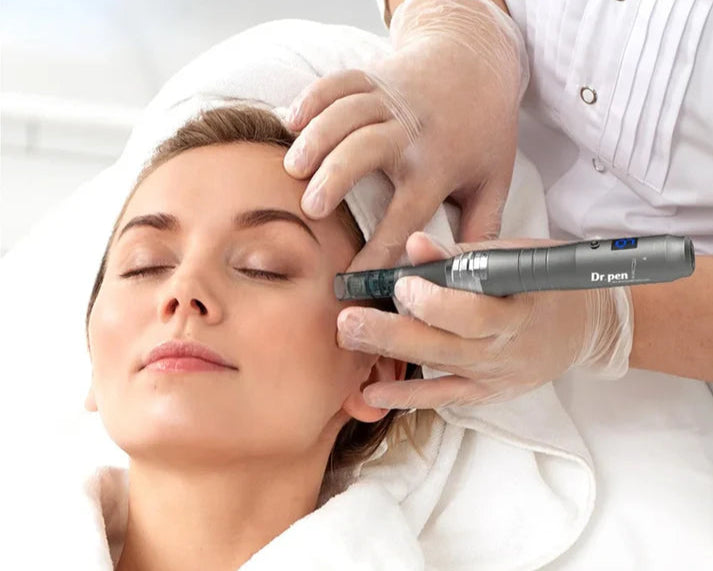Microneedling, a popular skincare procedure, has gained considerable attention for its potential to rejuvenate the skin, improve texture, and reduce the appearance of scars, wrinkles, and pigmentation. One of the tools commonly used for this purpose is the microneedling pen. While this device can work wonders, the idea of numerous tiny needles puncturing the skin can understandably cause some anxiety and discomfort for many. However, with the right approach, it's possible to minimize the discomfort associated with microneedling pen use. Here are some comprehensive strategies to help you have a more comfortable experience.

Understanding Microneedling and the Role of the Microneedling Pen
Microneedling involves creating controlled micro-injuries to the skin's surface using fine needles. This process stimulates the body's natural healing response, encouraging the production of collagen and elastin. The microneedling pen is a handheld device equipped with adjustable needle cartridges that penetrate the skin at varying depths. When used correctly, it can address a range of skin concerns, from fine lines and acne scars to uneven skin tone and texture.
Preparing for Your Microneedling Session
Proper preparation is crucial for minimizing discomfort and ensuring optimal results. Here are some steps to follow before your session:
Consultation with a Professional: Schedule a consultation with a trained and experienced skincare professional. They can assess your skin type, discuss your concerns, and tailor the treatment plan accordingly. This step is vital for understanding what to expect and addressing any apprehensions you may have.
Avoid Blood Thinners: If possible, avoid taking blood-thinning medications, such as aspirin or ibuprofen, a week before your session. These medications can increase bleeding and bruising.
Skincare Routine Adjustments: Stop using harsh skincare products, including retinoids and exfoliants, at least a week before your treatment. These products can make your skin more sensitive.
Stay Hydrated: Drink plenty of water in the days leading up to your session. Hydrated skin is more resilient and can better tolerate the procedure.
Cleanse and Moisturize: On the day of your appointment, cleanse your skin thoroughly but gently. Apply a lightweight moisturizer to keep your skin hydrated without leaving a residue.
Techniques to Minimize Discomfort During the Procedure
While some level of discomfort is normal with microneedling, several techniques can help make the experience more tolerable:
Topical Numbing Agents: Applying a topical numbing cream or gel before the procedure can significantly reduce pain and discomfort. Your skincare professional can recommend an appropriate product and instruct you on how long to leave it on.
Gradual Needle Depth Adjustment: Start with a shallower needle depth, especially if you're new to microneedling or have sensitive skin. Gradually increasing the depth allows your skin to adjust and minimizes initial discomfort.
Slow and Steady Motion: The professional performing the treatment should use a slow and steady motion when gliding the microneedling pen over your skin. This approach ensures even coverage and reduces the risk of excessive irritation.
Customized Treatment Areas: Focus on treating one area at a time, starting with less sensitive parts of your face, such as the forehead, before moving on to more sensitive areas like the cheeks and around the mouth.
Use of Soothing Products: Some professionals may apply a soothing gel or serum during the procedure to help lubricate the skin and reduce friction, thereby minimizing discomfort.
Post-Procedure Care to Enhance Comfort and Healing
The aftercare following microneedling is just as important as the procedure itself. Proper post-treatment care can alleviate discomfort and promote faster healing:
Cool Compresses: If you experience any redness, swelling, or mild discomfort after the procedure, applying cool compresses can help soothe the skin.
Gentle Cleansing: Continue to cleanse your skin gently with a mild, fragrance-free cleanser. Avoid scrubbing or using hot water, as this can irritate the skin.
Hydration and Moisturization: Use a hydrating serum or moisturizer to keep your skin well-hydrated. Look for products that contain ingredients like hyaluronic acid, which can help锁住moisture and support the healing process.
Sun Protection: Your skin will be more sensitive to the sun after microneedling. Apply a broad-spectrum sunscreen with an SPF of at least 30 daily, and avoid direct sun exposure as much as possible.
Avoid Irritants: Steer clear of harsh skincare products, alcohol-based toners, and exfoliants for at least a week post-treatment. These can irritate the skin and delay healing.
Follow Professional Advice: Adhere to any specific post-care instructions provided by your skincare professional. They may recommend specific products or additional treatments to enhance your results and comfort.
Managing Expectations and Potential Side Effects
It's essential to have realistic expectations and understand that microneedling may come with some temporary side effects. These can include redness, swelling, mild bruising, and a sensation similar to a sunburn. In most cases, these side effects subside within a few days to a week. If you experience persistent or severe discomfort, contact your skincare professional immediately.
The Role of Mindset in Minimizing Discomfort
Lastly, your mindset plays a significant role in how you perceive and experience discomfort during microneedling. Practicing relaxation techniques, such as deep breathing or meditation, can help you stay calm and reduce anxiety. Remember that the short-term discomfort can lead to long-term skin improvements, making it a worthwhile investment in your skincare journey.
In conclusion, while microneedling with a microneedling pen can cause some discomfort, following the strategies outlined above can significantly enhance your comfort during and after the procedure. Proper preparation, the use of numbing agents, gradual needle depth adjustment, and diligent post-care are key to a more tolerable and effective microneedling experience. By working with a qualified professional and adopting a positive mindset, you can achieve smoother, more radiant skin with minimal discomfort.

Share:
The Best Microneedling Pen for Sensitive Skin
Choosing the Right Serum to Use with Your Microneedling Pen